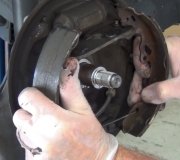By far the most common cause of a dragging brake is a constricted rubber flex hose. You can verify this by parking on a slight incline, shifting to neutral, releasing the brakes, then observing the vehicle doesn't creep downhill on its own. Next, place a block downhill of one of the tires, crawl underneath and open the bleeder screw on the caliper, then the brake will release. In all such cases where pressurized brake fluid gets trapped and won't flow back to the reservoir, we open the system at various places to see where that fluid is being blocked. Most often that is the steel lines at the master cylinder. With a constricted flex hose, loosening the lines at the master cylinder will not let the dragging brake release.
What happens is water gets inside the crimp where the metal bracket is attached to the hose, (red arrow). Rust develops and constricts the hose as it builds up. You can force brake fluid through the restriction to apply the brakes, then the trapped fluid can't return to the reservoir. The dragging brake generates excessive heat which migrates into the brake fluid. That heat makes the fluid expand and apply the brake even harder until the vehicle won't move, or that brake will be smoking if you force the vehicle to keep moving.
Most professionals will replace the hose, but it is just as effective to use a large flat-blade screwdriver or a Channel Lock pliers to spread that crimp open a little. This is fairly common on a lot of other models.
Image (Click to make bigger)
Thursday, June 2nd, 2022 AT 12:58 PM



